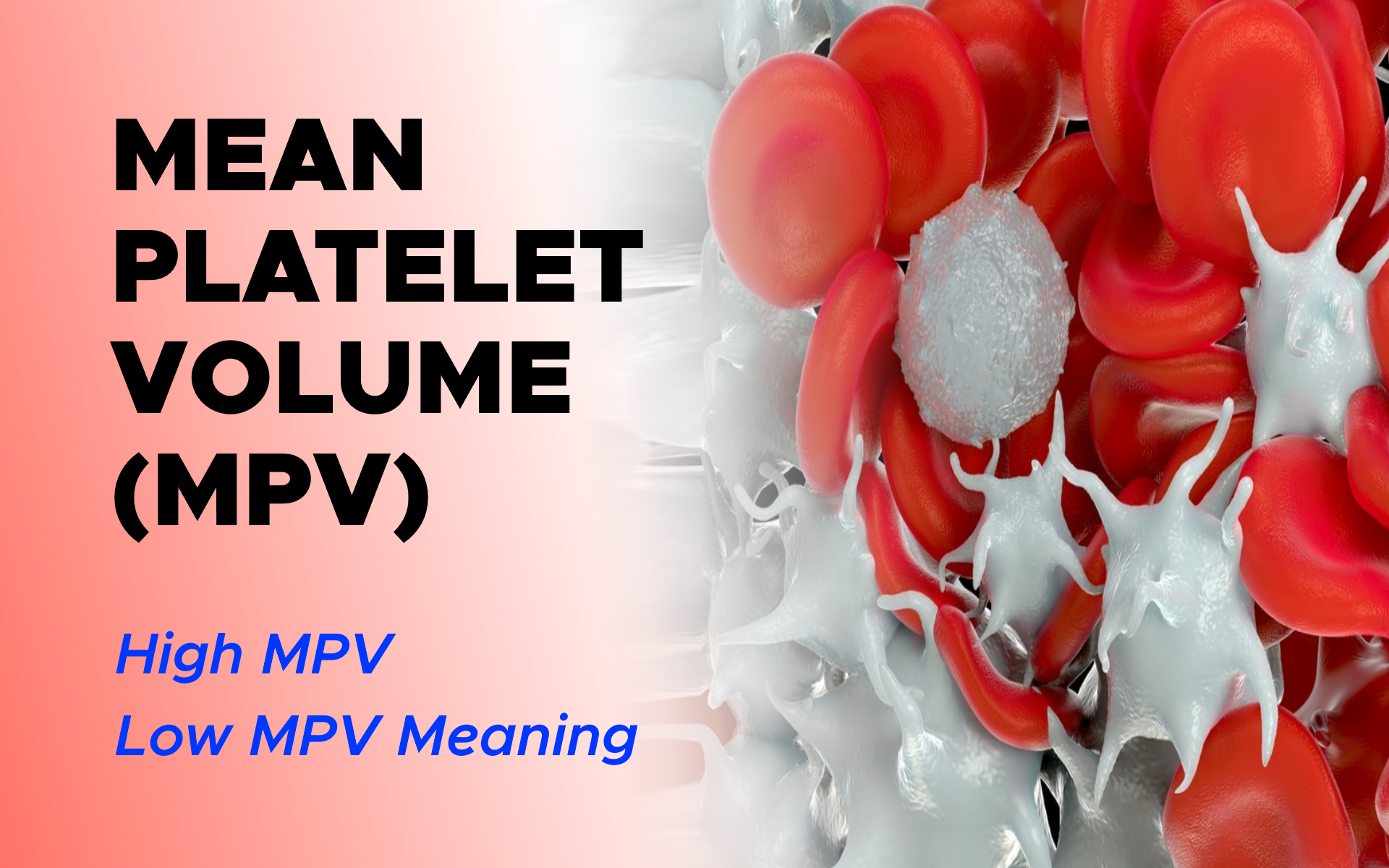
Understanding Mean Platelet Volume (MPV) Blood Test: High MPV, Low MPV Meaning
What are Platelets?
One of the most common tests that doctors run is a complete blood count (CBC). CBC is an umbrella term for a series of tests that look at specific types of cells in your blood. One of the tests run during a CBC is a mean platelet volume (MPV) test. A mean platelet volume (MPV) test measures the average size of your platelets. It’s closely related to a platelet count test, which measures the number of platelets in your blood.
Platelets, or thrombocytes, are small, irregular shaped blood cells that heal wounds and prevent bleeding. These are fragments of a bigger cell called megakaryocyte that is produced in the bone marrow. Newly formed platelets are larger compared to older ones. The average life of a platelet is 8-10 days.
How Do Platelets Work?

When platelets come in touch with any disruption in the vessel walls, they form clumps and clots to stop the bleeding. They do this by sticking to the injured site, clumping together, and attracting other platelets by chemicals. The trigger can be a small cut or an irregularity in the arteries, leading to the clumping, blocking of circulation, and damaging the affected organ, such as a heart attack.
In cases of large, intra-vessel clots, these can break off into smaller pieces and travel to other areas of the body leading to similar blockage situations in the limbs.
Immobile patients such as bedridden, post-operative, and post-trauma, can develop clots in their legs disturbing the circulation; on movement, his clot or its broken pieces can dislodge and severely damage the lung circulation.
Platelet Count:
Platelet count is a test that gives the average number of platelets per microliter (mcL) of blood.
Mean Platelet Volume (MPV):
Mean platelet volume (MPV) is the average size of a platelet. It also gives an estimate of how old the platelets are. It is a machine-calculated measurement.
Sometimes, the platelets clump together and appear falsely enlarged and in lower numbers.
Some studies suggest that high MPV is a predictor of heart diseases and stroke.
Both these tests are part of the health-screening test, CBC. But these can also be advised exclusively to diagnose, assess, and monitor bleeding and clotting diseases, bone marrow disorders, and other conditions. A blood sample is usually drawn from a vein in the arm and used for the test.
MPV Blood Test
Mean platelet volume (MPV) stands for mean platelet volume. Platelets are small blood cells that are important for blood clotting, the process that helps you stop bleeding after an injury. A Mean Platelet Volume (MPV) blood test measures the average size of your platelets. The test can help diagnose bleeding disorders and diseases of the bone marrow.
An MPV blood test is used to help diagnose or monitor a variety of blood-related conditions. A test called a platelet count is often included with an MVP test. A platelet count measures the total number of platelets you have.
MPV Ranges:
The ideal range of number of platelets is from 150,000 to 400,000 platelets/mcL, while the average volume of a platelet is about 9.4 to 12.3 fL
High MPV
A high mean platelet volume (MPV) means a larger platelet size. This indicates that a large number of new cells are released into the circulation by the bone marrow, either to compensate for any excessive breakdown of platelets or to promote healing.
High MPV can be observed with a high, low, normal, or variable platelet counts. A disease may affect the platelet count in multiple ways.
High MPV with Low Platelet Count:
The bone marrow is producing platelets but they get destroyed in the circulation, such as in:
- Immune thrombocytopenic purpura
- Pre-eclampsia of pregnancy
- Myeloproliferative disorders
- Recovery from hypoplasia
- Infections
- Toxins
High MPV with Normal Platelet Count:
This is seen commonly; the bone marrow compensates for any loss of platelets:

- Leukemia
- Thyroid disorders
- Myocardial infarct
- Diabetes
- Megaloblastic anemia
- Chronic kidney disease
- Vasculitis
- Disseminated intravascular coagulation
- Types of von wille brand disease
High MPV with High Platelet Count
Improper functioning platelets give the false impression of low platelets, so the bone marrow compensates by producing more platelet, such as in genetic mutations and cancer.
High MPV with Variable Platelet Count
- Bernard-Soulier syndrome (Giant platelet syndrome)
- Erythropoietin administration
- Diabetes
- Heart diseases, valvular diseases
- Hyperthyroidism
- Liver diseases
- Respiratory diseases
- Sepsis
- Pre-eclampsia of pregnancy
Low MPV:
Low MPV tells that the platelets are smaller than the ideal size. It may occur with different platelet counts similar to high MPV.
Low MPV with Low Platelets:
Since older cells are smaller, this suggests a problem in the production line of the platelets, so the number of platelets may also be less.
This happens in diseases that affect the bone marrow, such as chemotherapy and Aplastic anemia, or Wiskott-Aldrich syndrome.
Low MPV with Normal Platelets:
This is commonly seen with chronic kidney failure.
Low MPV with High Platelets:
This pattern is observed in infection and inflammatory diseases, such as inflammatory bowel diseases.
Low MPV with Variable Platelets:
Conditions that show variable platelet count include:
- Bone marrow failure
- Lupus
- Enlarged spleen
- Hypothyroidism
- Iron deficiency
- HIV/AIDS
- Medications
Factors affecting MPV:
Altitude, hormones, and other factors affect MPV; high altitudes, smoking, high blood pressure, high blood glucose, menstruation, and oral contraceptives are associated with higher MPV levels.
Summary
Platelets are an essential component of the blood. These prevent excessive bleeding in case of trauma and form clots. They are measured in the blood as platelet count and mean platelet volume. The mean platelet volume (MPV) is interpreted on individual basis with the platelet count and not on it’s own.



